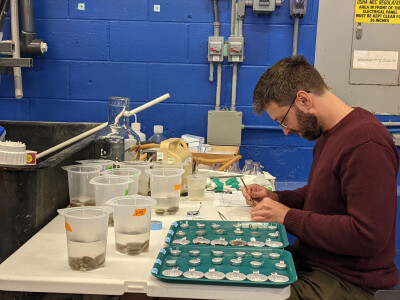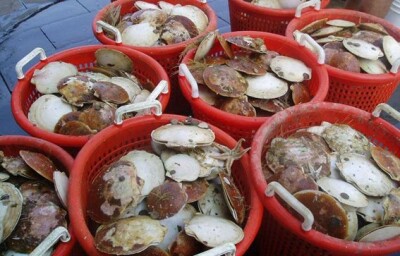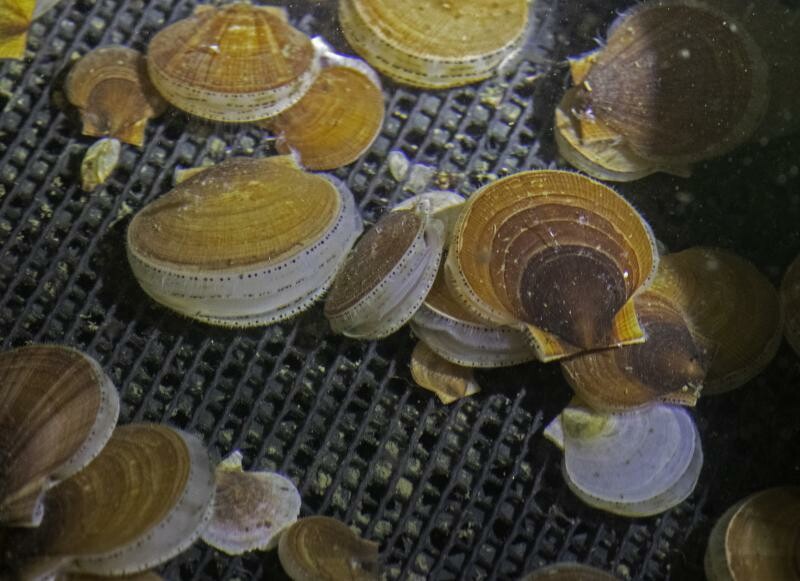A new study published in the journal PLOS Climate indicates that ocean acidification conditions projected between now and 2100 depress the growth of juvenile Atlantic sea scallops. Ocean acidification is caused by the ocean absorbing carbon dioxide from the atmosphere, resulting in chemical changes that increase acidity. Ocean warming may further hinder growth. Atlantic sea scallops support one of the most valuable fisheries in the United States, worth $670 million in 2021.
Postdoctoral researcher and lead author Emilien Pousse said, “This work describes the energetic balance of sea scallops under ocean acidification conditions for the first time, a species of economic and socio-cultural importance. Within our changing world, getting to know how our marine resources and fisheries could be affected by ocean warming and acidification in the near future is the key to anticipate the upcoming changes.”
The 8-week study was a collaboration between NOAA Fisheries and Massachusetts Maritime Academy in Buzzards Bay, Massachusetts. Faculty and students helped NOAA scientists conduct the study at the campus’ aquaculture lab. Scientists exposed the scallops to three different carbon dioxide levels and measured their growth and metabolism, including feeding, respiration, and excretion rates. Ocean acidification conditions significantly reduced the scallops’ ability to take up energy.
The NOAA Ocean Acidification Program, which funded this work, has a mission to better prepare society to respond to changing ocean conditions and resources by expanding our understanding of ocean acidification.
Dwight Gledhill, deputy director of NOAA’s Ocean Acidification Program, explained further. “Sea scallops represent a critically important fishery for New England and the Mid-Atlantic,” he said. “Because the effects of ocean acidification can vary considerably from species to species, it is necessary that we conduct targeted studies on sea scallops to better evaluate the risk ocean acidification may pose to them in coming decades.”
Dvora Hart is the lead assessment scientist for the species at NOAA Fisheries as well as a co-author of this study. She has studied Atlantic sea scallops for 24 years.
“This is the first information on post-larval scallop growth under ocean acidification,” she noted. “I previously worked on computer modeling studies with Woods Hole Oceanographic Institution oceanographers focused on climate change and ocean acidification effects on sea scallops. At the time, we did not have experimental data on sea scallop response. We estimated it based on what we knew about other scallop species and oysters. We now have real data on how sea scallops respond, filling a major gap in our knowledge.”

Massachusetts Maritime students – called cadets – gained hands-on research experience while collecting samples and caring for the scallops during the experiment.
"It was thrilling to see the Massachusetts Maritime Academy laboratory facilities used for such important scientific work,” emphasized Bill Hubbard, marine ecology professor and co-author of the study. “All of the NOAA scientists took time to engage undergraduates and inspire our future scientists."
While the ocean absorbs about a quarter of the carbon dioxide produced by human activities, the pH of ocean water varies based on oceanographic dynamics, depth, and season. Sea scallops live on the seafloor from Canada to North Carolina. Survey data show that pH is decreasing in the northern latitudes of their range, including the Gulf of Maine and Georges Bank, more rapidly than in other areas. Bottom water on the Northeast U.S. Continental Shelf is also warming three times faster than the global average.
“We tend to think of ocean acidification and climate change as off in the future, but the data show that environmental conditions in some areas of this scallop’s range are already approaching those we used in this experiment,” NOAA research chemist and co-author Shannon Meseck explained. “We now know the range where we can expect to see effects on scallop growth.”
Scientists are refining their predictions for scallops by monitoring their habitat, conducting lab experiments that approximate current and future conditions, and computer modeling. “This allows us to identify areas where scallops are already or will soon experience conditions beyond their threshold of tolerance,” Meseck said.
Scientists from NOAA Fisheries, the University of Connecticut, and the Commercial Fisheries Research Foundation are sharing these findings with sea scallop fishermen and their communities and working together to make management recommendations. They are holding engagement workshops with fishing communities in Massachusetts, New Jersey, and Virginia, the states with ports where fishermen land the majority of U.S. sea scallops.

James Gutoswki is a scallop fisherman who participated in the two workshops held in Barnegat Light, New Jersey. Gutoswki started scallop fishing in 1980, advancing from mate to captain to owner of several fishing boats. He became involved in fishery management in the late 1990s when he learned from experience that input from fishermen was critical to the process. He has served as chair of the New England Fishery Management Council’s Sea Scallop Advisory Panel for the past eight years.
“While I’ve never been a large proponent of climate change, I had to take off my rose-colored glasses to see objectively that it is occurring. Ocean acidification is a long-term problem affecting the scallop fleet, while bottom temperatures are something I’m concerned about in the near term,” he explained.
“When I’m hearing about this, I’m on the edge of my seat,” he said. “I want to know what the industry and managers can do to keep the fishery alive and well. For example, could adding shell to the bottom help, or enhancing production in areas that have the most favorable conditions for scallop growth?”
Gutoswki notes the importance of industry involvement in reporting observations of scallop habitats. “As a fisherman, you look back and see that things change. You notice anomalies and wonder: is this a swing or a long-term trend? Is this related to ocean acidification or something else in the environment?” The results of this study show that juvenile scallops are vulnerable to ocean acidification and warming temperatures during short-term exposure. Less is known about their ability to acclimate when exposed to these conditions throughout their lives, or whether they can genetically adapt across multiple generations.
“Scallops have been around for 250 million years,” explained assessment scientist Hart. “They may have something in their genome that allows them to adapt to increased carbon dioxide, but the only way to tell is to do the experiments.”
Scientists at NOAA Fisheries’ Milford Lab are currently following up on these findings with a three-year study to understand whether scallops may be able to adapt to changing ocean chemistry over multiple generations. They are using bay scallops because they are genetically similar to sea scallops and mature and reproduce more quickly.
They will measure survival, growth, development time, and physiological processes including feeding and respiration. They aim to find out if the second or third generations of scallops grown in ocean acidification conditions show signs of adaptation.






